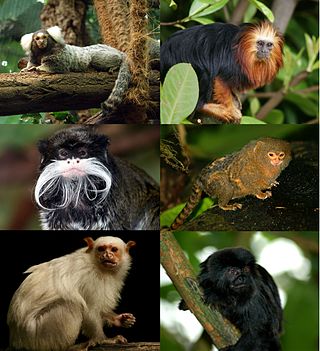
The Callitrichidae are a family of New World monkeys, including marmosets, tamarins, and lion tamarins. At times, this group of animals has been regarded as a subfamily, called the Callitrichinae, of the family Cebidae.

The pied tamarin, sometimes referred to as the Brazilian bare-faced tamarin, is a critically endangered species of primate found in a restricted area of the Brazilian Amazon Rainforest. It was named the mascot of Manaus, Brazil in 2005. The species is endangered due to the increasing size of the city of Manaus which is encroaching on their native habitat.
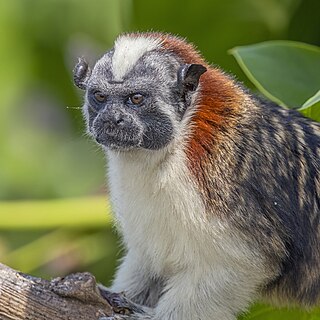
Geoffroy's tamarin, also known as the Panamanian, red-crested or rufous-naped tamarin, is a tamarin, a type of small monkey, found in Panama and Colombia. It is predominantly black and white, with a reddish nape. Diurnal, Geoffroy's tamarin spends most of its time in trees, but does come down to the ground occasionally. It lives in groups that most often number between three and five individuals, and generally include one or more adults of each sex. It eats a variety of foods, including insects, plant exudates, fruits and other plant parts. Insects and fruits account for the majority of its diet, but exudates are also important. But since its teeth are not adapted for gouging trees to get to the sap, it can only eat exudates when they are easily available.
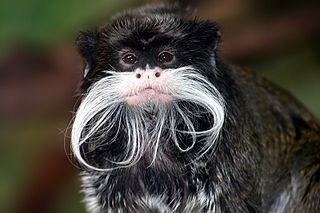
The tamarins are squirrel-sized New World monkeys from the family Callitrichidae in the genus Saguinus. They are the first offshoot in the Callitrichidae tree, and therefore are the sister group of a clade formed by the lion tamarins, Goeldi's monkeys and marmosets.

The cotton-top tamarin is a small New World monkey weighing less than 0.5 kg (1.1 lb). This New World monkey can live up to 24 years, but most of them die by 13 years. One of the smallest primates, the cotton-top tamarin is easily recognized by the long, white sagittal crest extending from its forehead to its shoulders. The species is found in tropical forest edges and secondary forests in northwestern Colombia, where it is arboreal and diurnal. Its diet includes insects and plant exudates, and it is an important seed disperser in the tropical ecosystem.

The white-lipped tamarin, also known as the red-bellied tamarin, is a tamarin which lives in the Amazon area of Brazil and Bolivia.

The emperor tamarin is a species of tamarin monkey allegedly named for its resemblance to the German emperor Wilhelm II. It lives in the north Brazilian states of Acre and Amazonas and the southwest Amazon Basin, in east Peru, north Bolivia.

The Atrato River is a river of northwestern Colombia. It rises in the slopes of the Western Cordillera and flows almost due north to the Gulf of Urabá, where it forms a large, swampy delta. Its course crosses the Chocó Department, forming that department's border with neighboring Antioquia in two places. Its total length is about 650 km (400 mi), and it is navigable as far as Quibdó, the capital of the department.

The golden-handed tamarin, also known as the red-handed tamarin or Midas tamarin, is a New World monkey belonging to the family Callitrichidae.

The black tamarin or western black-handed tamarin is a species of tamarin endemic to Brazil.

The moustached tamarin is a New World monkey and a species of tamarin. The moustached tamarin is named for the lack of coloring in the facial hair surrounding their mouth, appearing similar to a moustache. As with all New World monkeys, the moustached tamarin is found only in areas of Central and South America.

The brown-mantled tamarin, also known as Spix's saddle-back tamarin, is a species of saddle-back tamarin. This New World monkey is found in the Southern American countries of Bolivia, Brazil and Peru. This omnivorous member of the Callitrichidae family is usually found in smaller groups ranging between 4 and 15 individuals. This species communicates vocally and largely rely their olfactory system. The brown-mantled tamarin is considered as a species of Least Concern by the International Union for Conservation of Nature, despite a decreasing population and being threatened by poaching, habitat loss and capture for the illegal pet trade.

The golden-mantled tamarin is a tamarin species from South America. It is found in Ecuador and Peru, specifically in the upper Amazon (lowland), east of the Andes in Ecuador, and Northeast Peru; between the Rio Curaray and Rio Napo in Peru.

The black-chinned emperor tamarin is one of the two subspecies of the emperor tamarin. Unlike the bearded emperor tamarin, it has no beard. It is distributed throughout the rainforests of Brazil, Peru, and Bolivia. Not much on its conservation is known, so it is listed as Data Deficient by the IUCN. After a gestation period of 140–145 days, females usually give birth to one or two young. It is the same size as the emperor tamarin and it eats almost the same food: bugs, spiders, fruit, tree sap, and nectar.
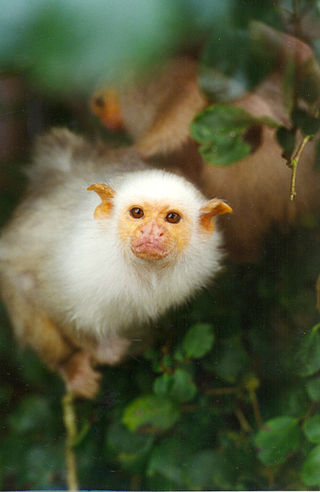
Mico is a genus of New World monkeys of the family Callitrichidae, the family containing marmosets and tamarins. The genus was formerly considered a subgenus of the genus Callithrix.
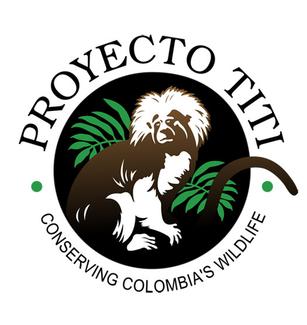
The Proyecto Tití was founded in 1985, to provide information to assist in conservation of the cottontop tamarin and their habitat in the tropical forests of Colombia. Proyecto Tití's programs combine field research, education and community programs. The cotton-top tamarin, is one of the most endangered primates in the world and is found only in North-Western Colombia.

The Magdalena–Urabá moist forests (NT0137) is an ecoregion in the north of Colombia. The terrain is largely flat or undulating, but includes mountainous areas in the south. It contains moist forests and large wetlands that are important to resident and migratory birds. The ecoregion forms a bridge between the Pacific coast ecoregions of Colombia and Central America, and the ecoregions of the Andes and Amazon. It is surrounded by the more populated parts of Colombia and is threatened by farming, ranching, logging, oil exploitation and water pollution in the main rivers.

Cruz Lima's saddle-back tamarin is a species of saddle-back tamarin, a type of small monkey from South America. Cruz Lima's saddle-back tamarin was formerly considered to be a subspecies of the brown-mantled tamarin, L. fuscicollis. It lives in Brazil in the area near the Inauini River. Its fur is mostly reddish orange, with a black tail and white eyebrows. The IUCN rates it as least concern from a conservation standpoint.

Geoffroy's saddle-back tamarin is a species of saddle-back tamarin, a type of small monkey from South America. Geoffroy's saddle-back tamarin was formerly considered to be a subspecies of the brown-mantled tamarin, L. fuscicollis. It lives in Loreto, Peru.

Weddell's saddle-back tamarin is a species of saddle-back tamarin, a type of small monkey from South America. Weddell's saddle-back tamarin was formerly considered to be a subspecies of the brown-mantled tamarin, L. fuscicollis. It lives in Brazil, Bolivia and Peru, with the type locality being in Bolivia.





















